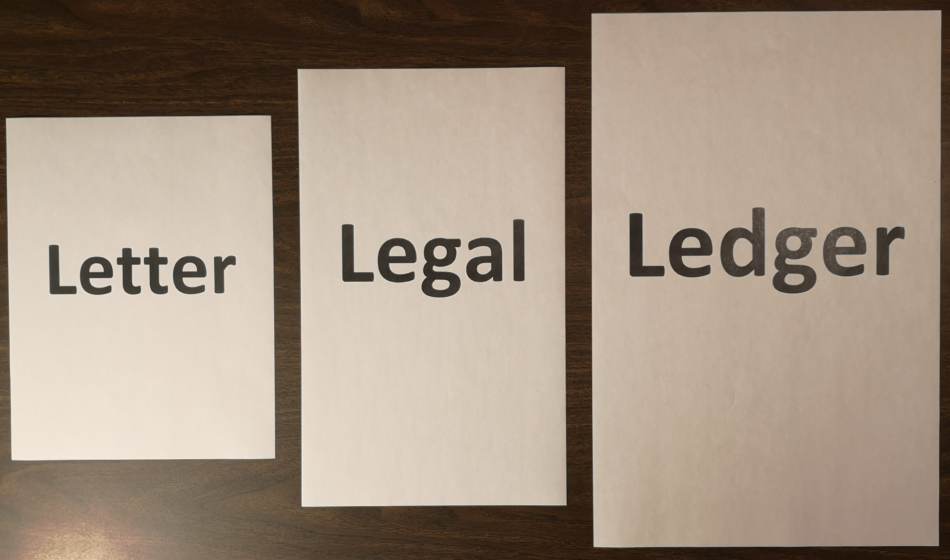In my experience, I’ve found that there are three main printer paper sizes. However, there is one printer paper size that stands out above the others.
The most common printer paper size in the USA and Canada is called Letter. It has a size of 8.5″x11″ or 216mm x 279mm with a 20lb weight, a White color, and brightness in the 90’s. The other two standard sizes are Legal, at 8.5″x14″ or 216mm x 356mm, and Ledger, at 11″x17″ or 279mm x 432mm.
Printer paper selection isn’t just about size. To find out more about printer paper selection and the details behind why you would select one type of paper over the other, read on.

Letter Printer Paper in Depth
Letter sized paper has established itself as the default standard for most business, education, and personal software. As such, letter paper is commonly available in most communities.
Its widespread usage has earned it the monikers of copy paper or printer paper even though other sizes are available. There are distinct differences between copy paper and printer paper, which also extend to their variants.
Copy paper is a bit thinner than printer paper, but you won’t notice the difference for text-only printing. For printing that includes some images, it is essential to use printer paper for image quality.
Otherwise, you may end up with wet-looking images that appear saturated with bleeding lines. The better results come from the slightly heavier weight and better quality of printer paper over copy paper.
For the average home user, the Letter size is the most common paper size used. Usually, nothing else is required. Letter sized paper is for everything from printing simple documents to school homework and assignments.
It’s the ideal size for printing off a document that needs to be sent in the mail or completed forms that need to be physically submitted. It’s the all-purpose workhorse of the paper sizes.
In the office, Letter paper size is the default size for the productivity software packages. PDF files, word processor files, and spreadsheet files default to be 8.5″x11″ when printed.
That includes work orders, invoices, and receipts generated by enterprise resource planning or ERP software packages. Reports and materials for meetings end up printed in the Letter size in abundance, so meeting attendees have the necessary material.
It’s possible to print letter-sized paper in standard portrait orientation or landscape. This naming convention has been borrowed from the art world because it clearly describes page orientation.
Portrait orientation is most commonly used for documents and is taller than its width. Landscape orientation has more width than height. Even though the standard document orientation is portrait, there are documents such as certificates designed for landscape orientation.
Printer Paper Properties
Printer paper comes in multiple weights representing thickness and allows you to use different thicknesses for different print jobs. The standard printer paper weight is 20lbs or 75.2gsm. Pounds or lbs is referring to the physical weight of a package containing 500 sheets.
On the metric side, gsm is grams per square meter. The thickness of the paper you use can be a communication tool to signify importance. The heavier the weight, the more prestige and emphasizes the significance the printed material has.
As an example, one way to leverage paper weight is for a resume. By printing your resume on a slightly heavier printer paper, it communicates to the holder right away that you’re serious and that this is an important document.
You can feel the difference in your hand. Often the small details that make you stick out among other candidates giving you the edge to win an offer. Give this a try on your next job application!
The brightness of your printer paper impacts your printed colors. Paper brightness is measured on a scale of 0 to 100 and indicates how much light the page surface reflects. A commonly used paper brightness is 92, but other brightness factors could be available depending on your vendor.
Choosing the correct brightness means your printed colors will be more vibrant, with more pop and better contrast. A paper brightness in the 90’s is what most people desire.
When you buy printer paper, it comes in packages of 500 sheets called reams. Reams can be purchased individually or in a box with multiple reams. Packaging can include three reams, ten reams, or whatever the manufacturer decides, so you will need to check what you’re buying before you buy it.
It depends on your printer, but many printer paper trays are big enough to hold a whole ream. Consider yourself lucky if yours does too!
The color of your paper may or may not impact your work. Even though printer paper is typically always white, three primary shades of white get used. The three main color groups are white or true white, cream white, and blue-white.
I’ve seen primarily white, followed by a minimal amount of cream-white used in an office setting. Blue white can give a perceived brighter white. For most users, white or true-white will be the best choice.
Ream Labels
The ream label provides all the paper properties that you need to make a buying decision. Gathering up all of the typical properties discussed gives us a loose standard for letter-sized printer paper. In the image below, we see the following properties.
- Sizing: 8.5″x11″ or Letter
- Weight: 20lbs
- Brightness: 92
- Color: White

Legal Printer Paper Size
Legal paper size gets its name from its historical use for official contracts. Stories of why a longer format got adopted don’t give a person confidence that we know where it originated.
Anything from lawyers’ desire for more note space on a single sheet to it was convenient to manufacture when it became adopted. Other accounts suggest it was a more random selection. Regardless, it can be the right size.
If you ever work with spreadsheets, schedules, or Gantt charts, you’re likely to end up in the situation where the width of your work on the software often doesn’t transfer to the printed form very well.
When it happens to me, it’s usually because I’m using a widescreen monitor, and I’m trying to print my work on a Letter-sized piece of paper. With a little adjustment, I can usually fit my work on a landscape orientation Legal sized sheet.
Many printers that can handle Letter sized paper can also take Legal sized paper. If you think you may need to print on Legal sized paper from time to time, confirm that the printer you’re buying can support it.
However, if you don’t work with significant contracts or need the additional space to print your work, you probably won’t have much use for Legal sized paper.
Ledger Printer Paper Size
Ledger size paper gets its name from its use in business, accounting, and other record-keeping activities where it gets used. Its size is twice the size of a Letter sheet with the joint on the long edge. It’s usually used with a heavier weight so that it can survive erasing multiple times. In practice, this size can be useful for printing technical drawings and large data sets.
Usually, the printers designed for working with Ledger style printer paper are in a different class and more expensive. You have to need to print this large to warrant the extra cost. Usually, it means having a multi-tray printer or, at the very least, a side-feed that is large enough to handle the Ledger size.
The average home user typically doesn’t have this need, so it isn’t something that most people have access to at home.
Where to Buy Letter Size Printer Paper
Fortunately, since Letter sized printer paper is so universally used, it’s carried by many vendors that may surprise you. Most small vendors that carry printer paper will stick to one type of paper that they know sells the best unless it’s an office supply store or an outlet for more paper varieties. Regardless of your favorite place to buy paper, you should have many options.
Happy printing!
